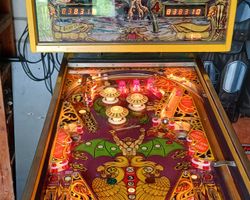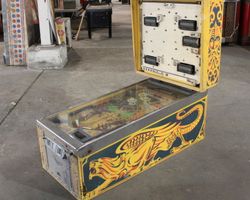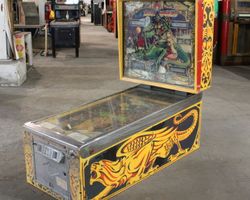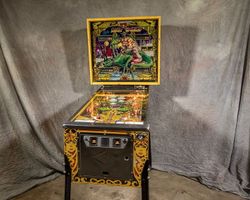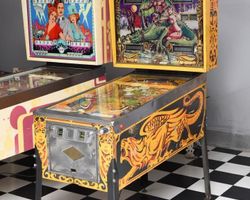Lost World
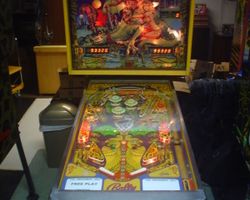
Average Prices: USD $300 to $1,400
Produced: August, 1978
Production Run: 10,330 units
Machine Type: Solid State Electronic
MPU: Bally MPU AS-2518-35
Players: 4
Design by: Gary Gayton
Art by: Paul Faris
Bally Manufacturing Corporation introduced Lost World to the pinball landscape in August of 1978, a solid-state electronic machine that marked several technical advancements for the company. With a production run of 10,330 units, this fantasy-themed game aimed to transport players to an uncharted realm, populated by ancient creatures and lush, mysterious environments. The machine's concept was brought to life through the creative vision of designer Gary Gayton, who crafted the playfield layout, while the striking visual identity was the work of artist Paul Faris. Faris, in a moment of candor, once playfully mentioned that the figures depicted on the backglass were inspired by himself and his wife, adding a personal touch to the machine’s aesthetic.
Lost World represented a pivotal moment for Bally’s engineering department. It was the inaugural machine to integrate the second-generation AS-2518-35 hardware, a significant upgrade that paved the way for future Bally designs. More notably, it was the first Bally pinball machine to feature electronic sounds, a radical departure from the traditional electro-mechanical chimes that had long defined pinball audio. This shift embraced new possibilities for sound design, though it was a change that would elicit varied responses from players. Furthermore, Lost World broke new ground by being the first Bally title to utilize a photographic backglass, moving away from purely illustrative artwork to incorporate a more realistic, detailed visual element.
The development process for Lost World also included intriguing experimental phases. Serial number ELW1008, an early production unit, housed a prototype pop bumper switch. Allan Reizman, who served as Engineering Lab Supervisor at Bally during this period, shed light on such test features. He explained that the first ten serial number games were typically hand-built lab samples and test units, used for design validation and modification before full-scale manufacturing. These initial machines often incorporated experimental components, like the unique bumper switch designed by Desi D'Percel. D'Percel, a mechanical innovator at Bally, conceived of a redesigned bumper switch intended to replace the conventional spoon-type mechanism. While intriguing, the prototype bumper was ultimately deemed too costly for mass production, though D'Percel’s work did lead to other innovations, such as a new one-piece bumper assembly that debuted on Eight Ball Deluxe. These early machines also showcased other developmental quirks, such as the speaker for the electronic sound system being housed in the backbox, simply because the cabinet had not yet been modified to accommodate it. These “first 10” games were used for continuous score testing by lab personnel before being sent to the factory as manufacturing samples, displayed at trade shows, or even given to the designers and key technical staff who brought the games to fruition.
Evolving Features and Visual Identity
The defining characteristics of Lost World emerge through its blend of new technology and established pinball elements. At its core, the game includes two flippers, three pop bumpers, and two kick-out holes that propel the ball across the playfield. A rollunder spinner offers a high-scoring opportunity when activated, and a messenger ball adds a unique playfield element, serving as a secondary target or objective. Another distinctive feature is the captive ball, a static target that players must hit precisely.
The introduction of electronic sounds marked a departure from the familiar melodic chime boxes. This new soundscape for Lost World was an attempt to provide a more dynamic auditory experience, complementing the visual journey through its prehistoric theme. While innovative for its time, this new sound system would become a point of discussion among players. Alongside the electronic audio, the photographic backglass was a bold aesthetic choice. Paul Faris’s artistry, which extended from this distinctive backglass to the cabinet and playfield, defined the machine’s visual identity. The detailed artwork depicts a world teeming with dinosaurs, exotic flora, and adventurous figures, creating an immersive backdrop for the pinball action. This artistic approach, combined with the groundbreaking photographic element, set a new standard for visual detail in Bally’s machines.
Navigating the Primeval Playfield
The playfield of Lost World presents a layout designed for straightforward yet engaging play. Three prominent pop bumpers are situated in the upper-right section, serving as primary ball motivators and score accumulators, often sending the ball ricocheting into various directions. Two kick-out holes offer opportunities for skill shots or bonus points, retrieving the ball from specific targets and returning it to play. A rollunder spinner strategically placed on the playfield encourages precise shooting for rapidly accumulating points. The single captive ball, set within a designated area, requires accurate aiming to strike repeatedly, contributing to the game's scoring objectives.
The playfield's design philosophy centers on accessibility and flow. The layout allows for a relatively open feel, enabling players to maintain ball control and execute various shots. While not overly complex, the placement of targets and features demands a degree of precision, encouraging players to master the angles and trajectories necessary for success. The artwork adorning the playfield continues the immersive fantasy theme established by the backglass. Lush jungles, towering volcanoes, and prehistoric creatures are meticulously rendered, drawing players deeper into the Lost World. Lighting is used to highlight key scoring opportunities and active features, guiding the player's eye and enhancing the visual experience as the game progresses. The overall aesthetic unifies the machine, ensuring that every element, from the art to the mechanical features, contributes to the overarching theme.
Gameplay Strategy and Progression
The gameplay dynamics of Lost World are characterized by a ruleset that is both approachable and rewarding. The primary objective revolves around advancing through specific targets and sequences to maximize scoring. Players aim to hit the various pop bumpers, rollunder spinner, and kick-out holes, each contributing to their score. A key element of progression is the "extra ball" feature, awarded upon completing specific, yet clearly defined, tasks on the playfield. This provides a tangible goal beyond mere point accumulation, encouraging players to extend their game time through skilled play.
While the game does not feature complex multi-ball modes or multi-layered quests often seen in later machines, its challenge lies in precision and consistent ball control. Strategic play often involves mastering shots to repeatedly activate the spinner, or accurately hitting the captive ball for sustained scoring. The pop bumpers, while providing an element of randomness, are crucial for keeping the ball in motion and generating points. For many, a memorable game involves successfully earning the extra ball and then pushing for a high score through a disciplined approach to shot selection and flipper control, attempting to avoid drains from less forgiving angles. The straightforward mechanics make it easy for new players to grasp, yet offer enough challenge to retain the interest of those seeking to refine their skills.
Reputation and Enduring Influence
Lost World holds a distinct place in pinball history, garnering a range of feedback from the pinball community. Its most frequently lauded aspect is its artwork, particularly the backglass. Many regard it as one of the most visually compelling and well-executed backglasses from the Bally era, often described as beautiful and detailed. The cabinet art also receives commendation for its intricacy and visual appeal, reinforcing the game’s strong thematic presentation. Players often appreciate the simple ruleset, finding it easy to understand and engage with, particularly those new to pinball. The flipper action is generally considered responsive, contributing to a satisfying gameplay experience. Some players also find the game challenging despite its apparent simplicity, valuing the need for precise shooting and ball control. For many, Lost World evokes a sense of nostalgia, representing a particular era of pinball design.
However, Lost World also receives criticism, primarily concerning its gameplay depth. Many find the experience to be simple and repetitive over extended play sessions, suggesting it lacks the enduring complexity of other machines. The electronic sounds, while technologically significant, are often described as cheesy, grating, or mismatched with the machine’s visual theme, with some players expressing a preference for the older chime sounds. Reviewers also point to a perceived lack of features, such as multiball, numerous drop targets, or more elaborate quest lines, which could have enhanced replayability. The playfield layout can sometimes lead to short, unpredictable games, a characteristic attributed to potential randomness and susceptibility to house balls. The repetitive nature of certain shots, and the perceived limited utility of the captive ball by some, also contribute to critical observations.
Despite these mixed views, Lost World's legacy is secured by its pioneering technological advancements. As the first Bally machine to utilize the AS-2518-35 MPU, electronic sounds, and a photographic backglass, it served as a foundational model for future Bally solid-state games. Its introduction of electronic sounds, while not universally loved, signaled a shift that would profoundly impact the auditory landscape of pinball, paving the way for more sophisticated sound designs in later machines. Similarly, the photographic backglass experiment showcased new possibilities for visual presentation, influencing how subsequent games would integrate artwork and realism. Lost World stands as a transitional machine, bridging Bally's earlier electro-mechanical designs with the burgeoning electronic era, and its impact on the industry's technological progression remains undeniable.
Sponsored Links
 Ebay Listings
Ebay Listings
 Auction Results
Auction Results
| Cost | Location | Date |
|---|---|---|
| EUR €1,890 |  Nordrhein-Westfalen, Germany Nordrhein-Westfalen, Germany |
28 September, 2025 |
| USD $170 |  Tennessee, United States Tennessee, United States |
18 May, 2025 |
| USD $1,940 |  Virginia, United States Virginia, United States |
23 January, 2025 |
| USD $3,889 |  Florida, United States Florida, United States |
19 December, 2024 |
| USD $1,020 |  Indiana, United States Indiana, United States |
19 November, 2024 |
| EUR €1,000 |  Italy Italy |
17 November, 2024 |
| EUR €1,000 |  Italy Italy |
09 October, 2024 |
| AUD $4,800 |  Victoria, Australia Victoria, Australia |
07 July, 2024 |
| USD $3,489 |  Florida, United States Florida, United States |
09 May, 2024 |
| EUR €1,990 |  Nordrhein-Westfalen, Germany Nordrhein-Westfalen, Germany |
31 March, 2024 |


Private Policy · Search Website · Contact Us
As an eBay Partner, we may earn a commission from qualifying purchases made through links on this site, at no additional cost to you.
All trademarks and copyrighted materials remain property of their respective owners. All other content copyright 2007 - 2025 Pinpedia.

